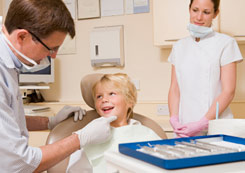Topical Fluoride
How fluoride will benefit your child
Dear Doctor,
Most every time I take my child to the dentist, she gives her a fluoride treatment. We already use fluoride toothpaste so does she really need it?

Dear Jessica,
This is an interesting question and the answer has many parts to it, but in general it is a quite resounding yes. Here's why:
Fluoride has a unique ability to strengthen enamel. Enamel, the hardest substance in nature is made up of an incredible crystalline substance called calcium hydroxyapatite. When fluoride is incorporated into the enamel it becomes calcium fluorapatite, which is much more resistant to acid attack (decay).
There are a couple of ways that fluoride becomes incorporated into the enamel: the first is during development which means when the teeth are forming. If you live in an area that has fluoride in the water supply (very little in fact, just one part per million, ppm), that's enough to grow teeth that are more resistant to decay. Your dentist or physician may have recommended dietary fluoride supplements for the same effect.
The second way to get fluoride into the enamel is following eruption of the teeth into the mouth (teething), whether primary (baby) or permanent (adult) teeth. This in fact is how fluoride is most effective. At a sub-microscopic level, the crystalline structure of the surface enamel continually changes. Fluoride ions (tiny active particles) can become incorporated into the tooth surfaces quite readily by topical (surface) application.
What about fluoride toothpaste use you ask? Fluoride toothpaste used daily is also effective in protecting enamel, but the concentration of fluoride in toothpaste is relatively low and varies from 850 – 1500 ppm, (equivalent to 0.24% for Sodium Fluoride and 0.75% for Sodium Monofluorophosphate, Stannous fluoride 0.474% commonly used in toothpastes) and which are the FDA standards for safety. Fluoride toothpastes can also affect bacteria in plaque, particularly stannous fluoride.
The concentrations of these topical fluorides are much higher than in toothpastes and they are applied for longer, up to four minutes per session generally.
What is the benefit of professionally applied fluoride treatment? Your dentist or pediatric dentist can apply fluoride directly to cleaned teeth surfaces for maximum effect. This surface application or what is known as “topical fluoride” can take many forms; gel, foam and varnishes (gels 12,300 ppm, and varnishes 22,600 ppm). The concentrations of these topical fluorides are much higher than in toothpastes and they are applied for longer, up to four minutes per session generally. Some of the fluoride varnishes once applied to the tooth surfaces will continue to leach fluoride into the tooth surface for a month or more.
Is topical fluoride right for every child? If you are at very low risk for decay, for example if your child grew up in a fluoridated water supply area; eats a low sugar diet with no sugar snacks; brushes twice daily with fluoride toothpaste and is flossed once daily — does all the right things to keep the risk of decay low, then topical fluoride will be less effective, but still helpful. On the other hand if your child is in a very high risk group; did not grow up in a fluoridated area, already has cavities, has high sugar and frequent sugary snacks, doesn't brush with fluoride toothpaste or floss and other negative factors, then more frequent topical fluoride (as well as other behavioral changes and measures) will not only reduce the risk of new cavities, it can also reverse very early decay (what we call demineralization — early breakdown of the surface crystal enamel structure.)
The last and most important factor to consider: Trust your dentist — your dentist will know your child's risk for decay, will monitor your child's teeth and other factors like diet, dental plaque control (how well you remove acid producing bacteria), seal the surfaces that decay where the toothbrush can't reach and more.
In 2006, the ADA issued guidelines for topical fluoride application based on years of clinical evidence-based research. All risk groups of children for decay with the exception of the very lowest, benefit from professionally applied topical fluoride. The guidelines go on to say, “It is recommended that all age and risk groups use an appropriate amount of fluoride toothpaste when brushing twice a day (pea size for children under 6 year olds). For patients with moderate and high risk of caries (decay) additional preventive interventions should be considered, including additional fluoride products at home, pit-and-fissure sealants and antibacterial therapy (special mouthiness).”
So a lot is dependent on the judgment of your dentist and your relationship with her. Please discuss this topic further with your general dentist or pediatric dentist.



